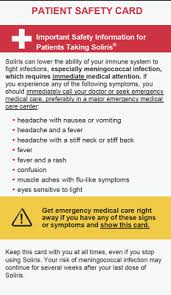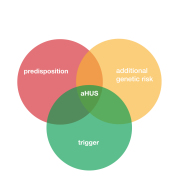Another trial of a complement inhibitor for aHUS treatment has been announced , it is for something currently called NM8074. Full details can be seen on Clinicaltrials.gov NCT05684159. HERE . NM8074 is being developed by NovelMed Therapeutics of Cleveland, Ohio, USA
It is in a small Phase 2 trial which has not started recruiting as yet. When it does start 12 patients with uncontrolled TMA will be sought to join two separate cohorts . Six will be recruited into Cohort 1 and will receive 7 doses of the drug at 2 week intervals. Cohort 2 patients will receive half the dose at weekly intervals for four weeks and then 5 full doses every two weeks.
Patients must be adult , 18 years old to 65 years. Hard luck if you are a late onset aHUS patient 66 years or older. Late onset is an emerging poorly understood aHUS issue, particularly affecting women , which makes this eligibility ruling rather questionable, if not somewhat ageist.
The drug will be administered by intravenous infusion.The study aim is to see if NM8074 results in remission from TMA in aHUS patients. It is also being trialed on PNH and MPGN patients. The aHUS trial is not scheduled to begin until June 2024.
NM8074 is an antibody that it designed to inhibit the function of Complement component Bb.
Bb is created when Complement Factor D chops Complement Factor B into 2 fragments Ba and Bb.
Bb sticks to C3 to create C3Bb which is called the C3 convertase which means it can chop other C3 proteins into two fragments C3a and C3b at an increasing rate Then C3Bb can stick to C3b to create the C5 convertase, C3BbC3b.
In turn the C5 convertase an chop C5 into C5a and C5b. C5b goes on to kick off the membrane attack complex, or MAC , C5b-C9. in aHUS patients it is uncontrolled MAC that causes their problems.
When NM8074 sticks to Bb none of alternative pathway activity can follow.
Efficacy of NM8074 will be judged on the usual primary outcome measures including platelet rise, LDH fall, haemoglobin rise , kidney function improvement etc at study day 120.
Also usual secondary outcome measures like time to achieve normal levels , or no longer needing dialysis etc.
Reported outcomes by patients include the usual FACIT Fatigue measure. However quality of life is reported by the patient using the European Organization for Research and Treatment of Cancer (EORTC) Quality of Life Questionnaire-Core 30 Scale (QLQ- C30), Version 3.0. This instrument also covers symptoms and functions.
Although there is no PRO questionnaire specific to aHUS, it is an odd way to measure aHUS patient outcomes given that aHUS is more of a kidney Illness, unlike PNH which is a benign blood disorder.
Unusually the study also includes other outcomes including measures of complement levels.
There are no surprising inclusion and exclusion criteria. The latter excludes pregnant women and those patients on dialysis , or swapping from another complement inhibitor.
At present there are no investigation sites listed.
And of course the aHUS patients likely to be recruited into the study have no idea of what will hit them in less than 18 months from now.
So one to watch for.
Article No. 566


